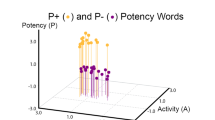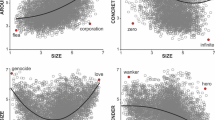Abstract
In a study of 185 adults ranging in age from 21 to 80 years, it was found that the older subjects' (ages 50 and above) responses on Zaichkowsky's ten-item, bipolar adjective, semantic differential, Personal Involvement Inventory were less internally consistent than the younger participants' responses. In addition to lower reliability, the older adults were more likely to omit multiple items in the scale. This was not the case for Likert-style items included in the study. Similar findings have been reported in a small number of other studies using other semantic differential scales. The semantic differential scaling technique needs a thorough examination for its generalizability to older populations.
Similar content being viewed by others
References
Cadotte, Ernest R., R. B. Woodruff, and R. L. Jenkins. (1987). “Expectations and Norms in Models of Consumer Satisfaction,”Journal of Marketing Research 24 (August), 305–314.
Celuch, Kevin, and Richard Evans. (1989). “An Analysis of the Convergent and Discriminant Validity of the Personal Involvement Inventory and the Consumer Involvement Profile,”Psychological Reports 15, 1291–1297.
Childers, Terry L. (1986). “Assessment of the Psychometric Properties of an Opinion Leadership Scale,”Journal of Marketing Research 23 (May), 184–188.
Drevenstedt, Jean. (1975). “Scale Checking Styles on the Semantic Differential Among Older People,”Journal of Gerontology 30:2, 170–173.
Goldsmith, Ronald E., and Charles Hofacker. (1991). “Measuring Consumer Innovativeness,”Journal of the Academy of Marketing Science 19 (Summer), 209–221.
Heise, David R. (1969). “Some Methodological Issues in Semantic Differential Research.”Psychological Bulletin 72:6, 406–422.
Jain, Kapil, and Narasimhan Srinivasan. (1989). “An Empirical Assessment of Multiple Operationalizations of Involvement.” InAdvances in Consumer Research, Vol. 17, Provo, UT: Association for Consumer Research, 594–602.
John, Deborah Roedder, and Catherine A. Cole. (1986). “Age Differences in Information Processing: Understanding Deficits in Young and Elderly Consumers,”Journal of Consumer Research 13:3, 297–315.
King, Charles W., and John O. Summers. (1970). “Overlap of Opinion Leadership Across Consumer Product Categories,”Journal of Marketing Research 7 (February), 43–50.
Mindak, William A. (1961). “Fitting the Semantic Differential to the Marketing Problem,”Journal of Marketing (April), 28–33.
Munson, J. Michael, and Edward F. McQuarrie. (1987). “The Factorial and Predictive Validities of a Revised Measure of Zaichkowsky's Personal Involvement Inventory,”Educational and Psychological Measurement 47, 773–782.
Ohanian, Roobina. (1990). “Construction and Validation of a Scale to Measure Celebrity Endorsers' Perceived Expertise, Trustworthiness, and Attractiveness,”Journal of Advertising 19:3, 39–52.
Osgood, C. E., G. J. Suci, and P. H. Tannenbaum. (1957).The Measurement of Meaning. Urbana, IL: University of Illinois Press.
Phillips, Lynn W., and Brian Sternthal. (1977). “Age Differences in Information Processing: A Perspective on the Aged Customer,”Journal of Marketing Research 24:4, 444–457.
Reid, David W., Gwen Haas, and Douglas Hawkings. (1977). “Locus of Control and Positive Self-Concept in the Elderly,”Journal of Gerontology 32:4, 441–450.
Stukovsky, Robert C., and Miroslav Palat. (1988). “Concept Reliabilities in a Clinical Semantic Differential,”Studia Psychologica 30 (4), 291–299.
Zaichkowsky, Judith Lynne. (1987). “The Personal Involvement Inventory: Reduction, Revision and Application to Advertising,” Working Paper, Simon Fraser University.
Zaichkowsky, Judith Lynne, and James H. Sood. (1988). “A Global Look at Consumer Involvement and Use of Products,”International Marketing Review 6:1, 20–34.
Author information
Authors and Affiliations
Additional information
Leisa Reinecke Flynn is assistant Professor of Marketing at Florida State University in Tallahassee, Florida. She wishes to thank Drs. Ronald E. Goldsmith and Charles Hofacker for their helpful insights.
Rights and permissions
About this article
Cite this article
Flynn, L.R. Do standard scales work in older samples?. Marketing Letters 4, 127–137 (1993). https://doi.org/10.1007/BF00994071
Issue Date:
DOI: https://doi.org/10.1007/BF00994071




